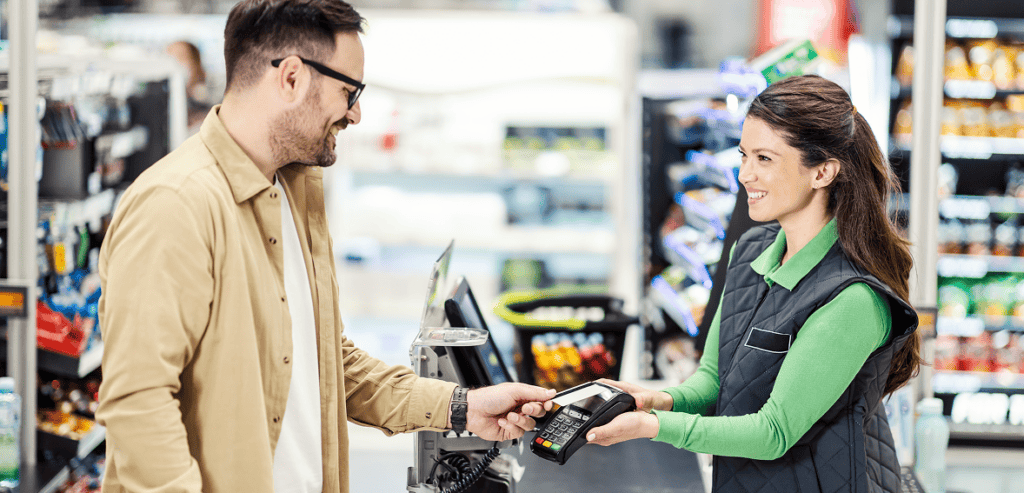
By Bethany Johnson February 21, 2025
In today’s digital era, businesses that accept Electronic Benefit Transfer (EBT) payments need a reliable and efficient Point-of-Sale (POS) system. Whether you run a grocery store, farmer’s market, or convenience store, choosing the right POS system can streamline transactions, ensure compliance, and improve customer satisfaction. However, with numerous options available, selecting the best POS system for EBT transactions requires careful consideration of features, costs, and benefits.
This article will guide you through everything you need to know about EBT-compatible POS systems. We’ll explore the essential features to look for, the costs involved, and the benefits of having the right system in place. By the end, you’ll have a clear understanding of how to choose the best POS system to meet your business needs.
Understanding EBT Transactions
What Is EBT?
Electronic Benefit Transfer (EBT) is an electronic system that allows recipients of government assistance programs, such as the Supplemental Nutrition Assistance Program (SNAP), to make purchases using a special debit card. The funds are loaded onto the card, which can then be used at authorized retailers for approved food and grocery items.
Why Do Businesses Need an EBT-Compatible POS System?
For businesses that accept EBT payments, having a POS system that supports these transactions is crucial. An EBT-compatible POS system ensures that transactions are processed quickly, securely, and in compliance with government regulations. Without the right system, businesses may face transaction errors, legal issues, or even penalties for non-compliance.
Key Features to Look for in an EBT-Compatible POS System

1. EBT Authorization and Compliance
The most critical requirement for an EBT-compatible POS system is the ability to process SNAP and other EBT transactions in compliance with government regulations. The system should be certified by the Food and Nutrition Service (FNS) and support PIN-based transactions for secure payment processing.
2. Dual Pricing Capabilities
Some businesses, particularly grocery stores, may need to differentiate between SNAP-eligible and non-eligible items. A good POS system should allow for easy identification and processing of these items within the same transaction.
3. Seamless Integration with Payment Processors
Your POS system should integrate smoothly with various payment processors, allowing you to accept credit cards, debit cards, and mobile payments in addition to EBT. This ensures a smooth checkout experience for all customers.
4. Inventory Management
An advanced POS system should have an inventory management feature that helps track SNAP-eligible products. This makes it easier for businesses to ensure they remain compliant with SNAP regulations while efficiently managing stock levels.
5. User-Friendly Interface
A simple and intuitive interface is essential for fast and hassle-free transactions. Employees should be able to process EBT payments quickly with minimal training, reducing wait times for customers.
6. Multi-Store and Mobile Compatibility
If you operate multiple locations or attend farmer’s markets, a mobile-friendly POS system with cloud-based access can be a game changer. This allows you to accept EBT payments on the go and manage transactions remotely.
7. Data Security and Fraud Prevention
EBT transactions require high levels of security to prevent fraud and ensure customer trust. Look for a POS system with encryption, PCI compliance, and real-time fraud monitoring.
8. Reporting and Analytics
A good POS system provides detailed reports on sales, EBT transactions, and inventory. This helps businesses track their revenue, understand customer buying patterns, and make informed decisions.
Costs of POS Systems for EBT Transactions
1. Hardware Costs
Most POS systems require hardware such as a touchscreen terminal, barcode scanner, card reader, and receipt printer. Prices vary depending on the brand and features but typically range from $500 to $3,000.
2. Software Costs
POS software can be purchased as a one-time fee or through a monthly subscription. Subscription-based services range from $30 to $200 per month, depending on the features offered.
3. Processing Fees
Unlike credit card transactions, EBT transactions usually do not have high processing fees. However, some payment processors may charge a small per-transaction fee, typically around $0.10 to $0.50 per transaction.
4. Installation and Setup Costs
Some providers charge setup fees for hardware installation and software configuration. These fees range from $100 to $500.
5. Maintenance and Support Fees
Many POS providers offer customer support and software updates for an additional fee. Some charge an annual maintenance fee, while others include support in the monthly subscription cost.
Benefits of Choosing the Right POS System for EBT Transactions

1. Faster Transactions and Improved Efficiency
A reliable POS system speeds up checkout times, reducing long lines and improving customer satisfaction.
2. Compliance with Government Regulations
Using an FNS-certified POS system ensures your business remains compliant with SNAP and other government programs, avoiding legal issues and penalties.
3. Increased Customer Convenience
Accepting EBT payments allows low-income customers to shop easily, expanding your customer base and increasing revenue potential.
4. Better Inventory Management
A POS system with inventory tracking helps businesses maintain adequate stock levels and prevent issues with SNAP compliance.
5. Detailed Sales Insights
Access to real-time reports and analytics helps businesses understand sales trends and optimize pricing strategies.
Top POS Systems for EBT Transactions
1. Square for Retail
- Affordable pricing with no long-term contracts.
- Integrates with multiple payment processors.
- User-friendly interface for easy transactions.
2. Clover POS
- Customizable hardware and software options.
- Robust inventory management tools.
- Secure EBT processing with fraud prevention.
3. NCR Silver
- Designed for grocery stores and markets.
- Multi-location support.
- Real-time reporting and analytics.
4. Shopify POS
- Great for businesses with both online and offline stores.
- Seamless payment integration.
- Advanced customer analytics.
5. Payanywhere
- Mobile POS option for farmer’s markets and pop-up shops.
- Low processing fees.
- Supports a variety of payment methods.
Conclusion
Choosing the best POS system for EBT transactions is crucial for businesses that serve SNAP beneficiaries. An efficient, secure, and government-compliant system ensures smooth operations, enhances customer satisfaction, and keeps your business competitive.
When selecting a POS system, consider key factors such as EBT authorization, inventory management, payment integration, and cost-effectiveness. With the right system in place, you can streamline operations, expand your customer base, and maintain compliance with federal regulations.
By investing in a high-quality POS system, your business can provide a seamless shopping experience for customers while optimizing efficiency and profitability. If you’re ready to upgrade your POS system, research your options carefully and choose the one that best fits your business needs.